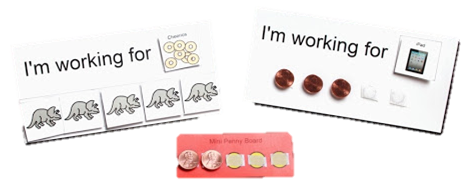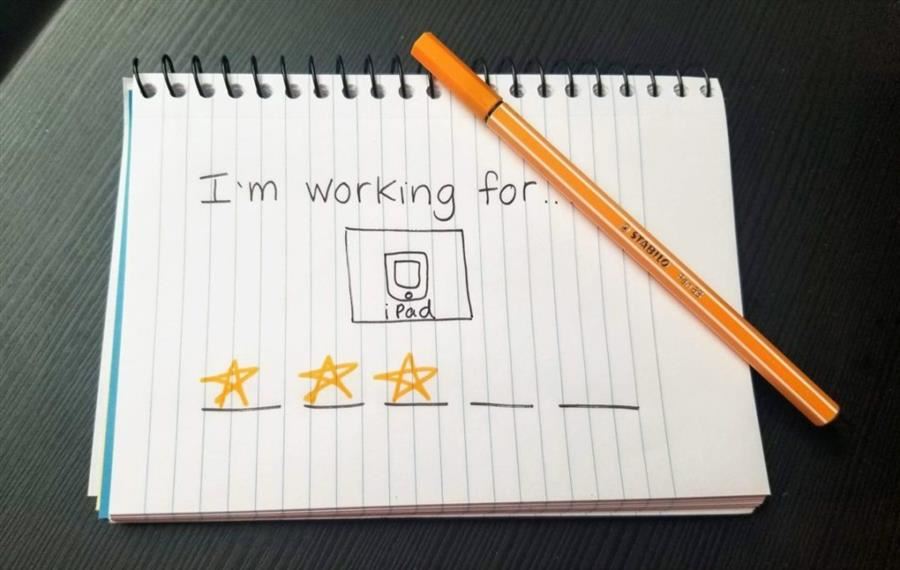-
Setting up Home Instruction for Students with ASD
A How-to Guide for ParentsMOTIVATE YOUR CHILD TO STAY ENGAGED AND COMPLETE TASKS
Children with ASD often show little interest in completing academic tasks and exhibit challenging behaviors when pressed to do so. Part of the issue is that the activities we ask children to complete are not meaningful from their point of view. Many are also not motivated by the customary rewards that drive typically developing children. So we have to find ways to make the schoolwork meaningful to your child from their point of view and/or to ensure that they are sufficiently motivated.
HOW TO DO IT
Identify the items, activities, and topics your child most enjoys. This information is critical to your child's success. Even if you feel that you have a good sense of what your child likes, it is very helpful to make a list. Many forms are available that help with this process including this Reinforcement Assessment Form or this Reinforcement Inventory Form.
Limit access to certain preferred items or activities so you can use them as reinforcers. Let's say a child's favorite activity is watching train videos on his iPad. If he has access to watching those train videos anytime he wants, it will be less effective as a reinforcement to increase positive behaviors. Consider holding back certain high-value rewards to help your child successfully complete non-preferred activities.
Provide access to preferred items and activities to reinforce completion of schoolwork tasks.
Now that you know what your child most enjoys, use those items and activities to entice your child to start tasks and then earn them for completing tasks. You can use a first/then visual that shows the less preferred activity on the left and the more preferred on the right. Use a simple verbal cue while pointing to the visual, such as "first math, then iPad". Use the preferred activity to entice your child to start the non-preferred activity. For example, say "Time for math, after that iPad time. First math, then iPad."
Classrooms often use first/then cards with removable visuals, but parents can easily create their own with pen and paper or use of a dry erase board. Here are a few templates you can download and print: First/Then Template, First/Then/Next Template
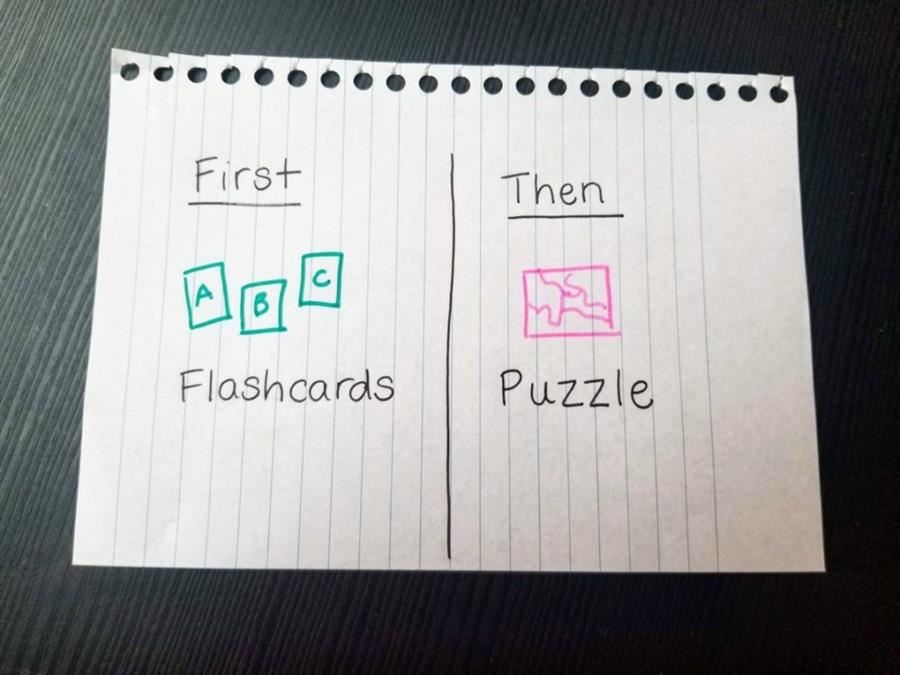
To be successful, some children will need to have a preferred activity scheduled after every non-preferred activity so that their routine alternates between less preferred/more preferred (e.g., math then iPad, writing then iPad, reading then iPad). This is because some children may not be ready to complete two to three non-preferred tasks in a row before being able to do a preferred activity, though over time they can work their way up to it. The first/then visual (pictured left) allows you to direct completion of multiple tasks before transitioning to the preferred activity.
Below is a great how-to video on using first/then visuals at home by an autism specialist at Cascase Regional Program at LBL ESD.
Caution: Avoid common pitfalls in the use of reinforcers (preferred items activities). Do not say to your child, "If you don't do your math then you won't get the iPad." When we do this, we shift the emphasis from reinforcing positive behaviors to punishing non-compliance. Threats to limit or take-away something your child likes will often make matters worse and trigger challenging behaviors.
Start with small, incremental steps and work your way up. We recognize that some children will refuse completing any schoolwork at all. If your goal is for your child to come to his work area, sit down, and complete a worksheet (or other task), we often need to systematically teach and reinforce every step in this process. The first step may be following the direction to come to a designated work area. As with the previous example, let's say the iPad is a powerful reinforcer for the child. You stand at his schoolwork area with iPad in hand and say, "Come here". When he walks over, give verbal praise and provide some time on the iPad. Once he is reliably coming over to the schoolwork area, you can target sitting down. Once he has learned to walk over and sit down, you place task in front of him and ask him to only do the first part, perhaps writing his name on the top of a worksheet. Then you stop and reinforce with iPad time.
End on a high note. Every child is at different developmental level with different skills. When your child is doing well, it is tempting to keep pushing to see how far they can go. Yet it is often better to release your child from a task demand while they are still doing well and deliver the reinforcing activity. For example, consider a 4th grade child who struggles with handwriting and has had major meltdowns related to writing tasks. Today, she is doing better than she ever has before and has written three sentences out of ten on a worksheet. She's doing well but is showing subtle signs of fatigue. A parent may be tempted to push and see if she can complete all ten items. Yet, it is better to stop while she is still doing well. So her parent says, "Great job! You wrote three sentences! Writing is all done. Time for a break."
Utilize your child's special interests to make tasks more interesting and meaningful. Another way to increase motivation is to somehow integrate your child's special interests into the task that you are having them complete. For example, let's say a first grade child with ASD has an intense interest in dinosaurs and loves to name every genus and species. We may be able to make first grade math meaningful from the child's point of view by presenting math worksheets based on a dinosaur theme - examples below.
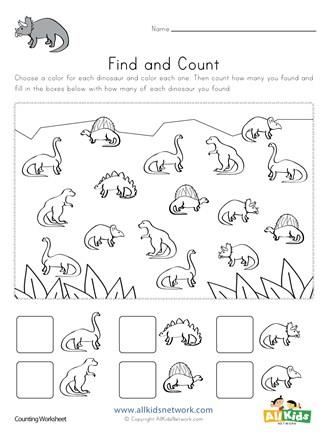
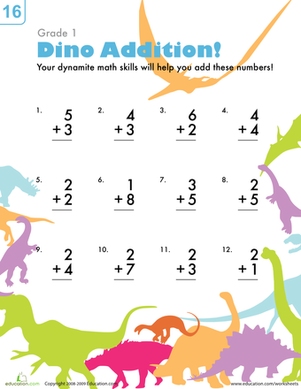
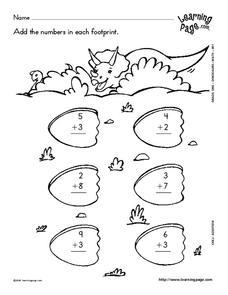
For older students, consider ways to adjust assignments to align with and take advantage of your child's strengths and areas of intense interest. Note that you or preferably your child should discuss any proposed assignment modifications with the teacher who assigned it in advance. Look for ways to take advantage of and build upon your child's special interests and skills. These special interests will carry many individuals with ASD into a successful profession as an adult!
Create positive associations. By alternating less preferred with more preferred (first/then), providing reinforcement for positive behaviors, integrating special interests, teaching skills one step at a time, and ending task demands while your child is still doing well - doing many or all of these things will hopefully result in your child creating a positive association with their schoolwork space and with the work itself.
We want your child to associate their schoolwork area as a place where good things happen, where they get access to the things and activities they love. Used effectively, positive reinforcement is very powerful in increasing skills and leading your child to create positive emotional associations with people and places. We want your child to develop positive associations with learning.
Use Token Boards and Point Systems
While some children need immediate reinforcement for completing tasks, token boards are a great tool for helping your child learn to accept delayed reinforcement while visualizing progress toward their goal. Token boards also allow you to continue reinforcing your child while they are working so they can complete schoolwork tasks without interruption. Token boards typically include spaces to place each token and a picture of what the child is working for. It is ideal to allow your child to choose what they want to earn.
Token board examples below include a template from Educate Autism (left), a few with Velcro attachable tokens (center), and a handwritten token board from The Autism Helper (right). If you have a printer at home, templates as as this token board 5 tasks and token board 10 tasks are available. You can also draw your own!
Using a Token Board1. Allow your child to choose what they would like to earn (select for them if needed). If possible, present their reinforcement choices on a list or visually presented on a choice board. It is important that the reinforcer is high value to your child, motivating enough to keep them engaged in a schoolwork task without the need for immediate reinforcement.
2. Each time the child completes a target task or behavior, name the behavior (e.g., “Sitting at table”) and hand your child a token. Ask them to place it on the token board (or if handwritten, draw a star on their token board).
3. When the token board is full, give your child the identified reinforcer and reset the board for use again.
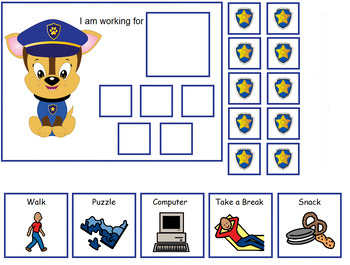 To further motivate your child, consider creating a token board that integrates their special interest (e.g., trains, horses, video games). The police-mouse token board (pictured right) was created for a young child with ASD with a special interest in police and badges.
To further motivate your child, consider creating a token board that integrates their special interest (e.g., trains, horses, video games). The police-mouse token board (pictured right) was created for a young child with ASD with a special interest in police and badges.Over time, you can adjust token boards to require more tokens to earn the reinforcer or fade use of the token board altogether.
Adjust for older students. If you have an older child, a more age-appropriate approach would be a points-based system. They can earn points that can be used like money to "purchase" preferred items or activities. A challenge for many parents is ensuring things that used to be free now have to be earned! If you have a middle school or high school son or daughter who desperately wants to purchase a new video game, then you can allow them to earn points for completing assigned schoolwork.
Token Board and Point System Cautions: If you setup a token board or points system, do not sabotage your own system with mistakes such as taking points away to punish problem behaviors (imagine how frustrating and demotivating it would be if your employer took away pay you already earned for any mistakes or policy violations!). Do not threaten to withhold or take away points (e.g., "If you don't finish that science assignment, you won't get any points." or "If you don't stop doing that, I'm going to take away 20 points). We do not want to turn a reinforcement system that builds skills and confidence into a punishment system that causes negative side effects.
Focus on the positive and limit corrective or critical feedback. If your child has a strong interest in a reinforcer and does not demonstrate the behaviors needed to earn it, then they are simply opting out of the positive reinforcement. This highlights why it is important to limit access to certain highly valued items and activities so that they can be used to motivate completion of schoolwork.
Be sure that the tasks or behaviors that you are asking your child to perform are things they can actually do. Dangling a carrot in front of child to do something they are not capable of will likely cause great frustration. To illustrate, imagine that you require corrective lenses to read signs and text that are 20 feet away or further. Consider now that I take away your glasses and tell you I'll give you $500 to read text on a white board across the room. You can't do it, so I increase the value of the reinforcement. I offer you $1000 to read it. How about $10,000? It doesn't matter how strong a reinforcer is if an individual is not capable of the skill we are trying to get them to perform.
MORE WAYS TO INCREASE MOTIVATION
Provide choices. Researchers have found that providing children with ASD opportunities for choice and control increases performance on academic tasks. For example, when directing your child to complete a writing assignment give them a choice of what to write with (pencil, red pen, or blue marker). When reading an assigned book, give them a choice of seating options (e.g., table, desk or bean bag)
Exercise before schoolwork. When children with ASD exercise before starting academic schoolwork, their level of engagement is significantly higher. In your child's daily schedule, consider including at least 20 minutes of rigorous exercise activity immediately prior to his or her schoolwork time. This could be time on a stationary bike, jumping on an indoor trampoline, or other activities. You can also build in movement breaks between schoolwork activities.
Provide sensory fidgets to increase engagement. During some activities, your child may need access to to a sensory item to stay engaged. For example, if your child is being asked to silently read for 15 minutes, they may benefit from use of a fidget that they can manipulate with their hands during that activity (e.g., small slinky, squishy ball, or foam stretchy toy).
Use flexible seating. Consider flexible seating options. As long as your child is engaging in the assigned task or activity, it’s ok if they sit on a therapy ball, lie on a bean bag, or stand at a table and rock back and forth.
Integrate fun into schoolwork, and learning into leisure. Look for ways to integrate fun and play into schoolwork. Your child can be learning valuable math and reading skills while playing a game. Conversely, academic learning opportunities can be brought into fun and leisure activities. For example, while taking a walk in the neighborhood you can explore science concepts that your child's class is currently studying (e.g., the type and shape of leaves, types of cloud formations, etc.).
In review...
➤ Write down which items and activities your child most enjoys
➤ Limit access to highly preferred items and activities so they can be used to reinforce behavior
➤ Reinforce your child for completing schoolwork
➤ Use a first/then visual, using more preferred activities to help your child complete less preferred tasks (e.g., "first math, then iPad")
➤ Integrate your child's special interests when feasible to make schoolwork more meaningful and motivating
➤ Use token boards and point systems to reinforce your child
➤ Find other ways to increase motivation and on-task behavior (e.g., provide choice, exercise, fidgets, flexible seating, etc.)
Additional Resources
Motivating Students Who Have Autism Spectrum Disorders
These Strategies Can Help Motivate Children on the Autism Spectrum
Token Economy: Tips and Resources for Teachers
Next page Tip 4: COMMUNICATE TASKS AND EXPECTATIONS CLEARLY
 Setting up Home Instruction for Students with ASD
Setting up Home Instruction for Students with ASD
A How-to Guide for ParentsDeveloped by autism specialists at Columbia Regional Program
Email questions or feedback to crpweb@pps.net





